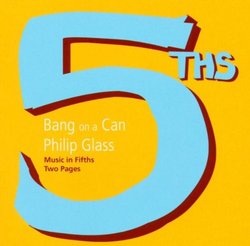| All Artists: Phillip Glass, Bang on a Can Title: Philip Glass: Music in Fifths; Two Pages Members Wishing: 2 Total Copies: 0 Label: Cantaloupe Release Date: 9/14/2004 Album Type: Import Genres: Dance & Electronic, Jazz, Classical Styles: Techno, Avant Garde & Free Jazz, Chamber Music, Historical Periods, Classical (c.1770-1830) Number of Discs: 1 SwapaCD Credits: 1 UPC: 713746289324 |
Search - Phillip Glass, Bang on a Can :: Philip Glass: Music in Fifths; Two Pages
 | Phillip Glass, Bang on a Can Philip Glass: Music in Fifths; Two Pages Genres: Dance & Electronic, Jazz, Classical
|
Larger Image |
CD Details |
CD ReviewsPretentious Compositions in the Hands of Excellent Performer Sor_Fingers | Boulder, CO USA | 02/25/2007 (3 out of 5 stars) "Read this First:
I LOVE Minimalism. Now that we've gotten that out of the way, let's talk about this record. I really like a lot of Phillip Glass's work, especially Glassworks and his soundtrack for Koyanisqatsi. However, these pieces really don't speak to me. Glass's extremely academic approach to these two pieces on this recording really is one reason why contemporary music gets such a bad reputation these days. This frustrates me because so many people automatically write off contemporary music as total rubbish. The problem with these pieces is that they seem to sound more like compositional exercises rather actual pieces intended for an audience to listen to. Both of these pieces are based off of about 5 different pitches and Glass takes a simple 5 note motive and takes you through extensions of it that frankly get incredibly monotonous. Even the lover of minimalism may be slightly bored over these two pieces. Nevertheless, Bang on a Can works well with this material that is not very accessible to a large audience. They play a lot with timbre and color to make the piece tolerable in spite of its monotony. Frankly I would much rather listen to Bang on a Can's light sounding ensemble (piano, marimba, flute, clarinet, cello, violin, electric guitar) than Phillip Glass's original recording (electric organ and saxophones or electric organ and piano). The sound here is very mellow, making the piece almost hypnotic, sending you into a dreamlike trance. Also, Bang on a Can's ensemble is incredible tight and well rehearsed. To perform this piece from memory would honestly test the capabilities of the human memory. BOAC plays this labyrinth of patterns and notes where each motive is just a little different from the other and prevails with flying colors. To think that 6 or 7 different musicians are playing these lines together in unison is really quite impressive. The only qualm that I have with the performance is that it lacks any kind of dynamic concept period. Everything is played at the same volume from start to finish. To be able to hear some kind of shape in volume would make this piece a lot more interesting. Whether that was a decision by the ensemble or honoring a request by the composer, I do not know. What I do know is that it would have been nice to here something change besides Glass's initial motive: and that didn't even change very much. The long and short of it is that there are better works by Phillip Glass and better recordings by Bang on a Can with far more interesting pieces. As a very zealous fan of minimalism, I can't say that I would recommend this recording. It's merely tolerable and I would say that this one is for completists only." |

 Track Listings (2) - Disc #1
Track Listings (2) - Disc #1